Positive Behavior Promotion: Paterson Health and Social Care Report
VerifiedAdded on 2023/03/21
|9
|2379
|35
Report
AI Summary
This report, prepared for Paterson Health and Social Care (UK-based), analyzes strategies for promoting positive behavior within healthcare contexts. It begins by identifying legislative measures related to restrictive interventions, including the Health and Safety at Work Act 1974 and the Mental Capacity Act 2005, and discusses various intervention strategies. The report emphasizes the significance of the least restrictive intervention process and the role of safeguards. It differentiates between proactive and reactive strategies, highlighting the importance of a child or person-centered approach. The report outlines best practices for promoting positive behavior, addressing different types of challenging behavior, and detailing steps to maintain individual dignity and respect, including the use of role-play for physical and mental well-being. The report emphasizes the role of effective communication and adherence to legal rules and regulations in creating a positive environment for patients. The report also provides a table comparing proactive and reactive strategies. The report concludes by summarizing the key findings and reiterating the importance of health and social care associations in supporting individuals facing mental instability and physical distress.
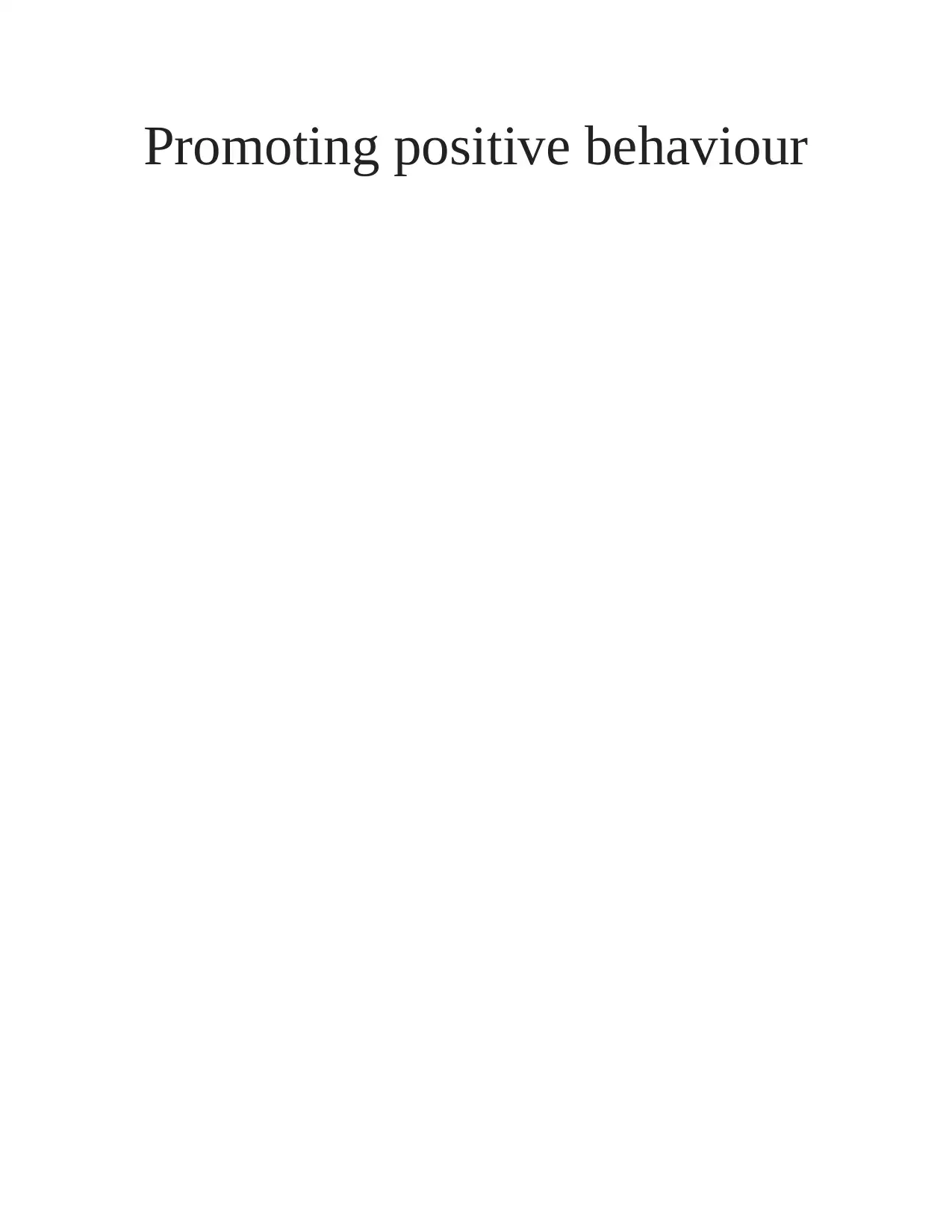
Promoting positive behaviour
Paraphrase This Document
Need a fresh take? Get an instant paraphrase of this document with our AI Paraphraser
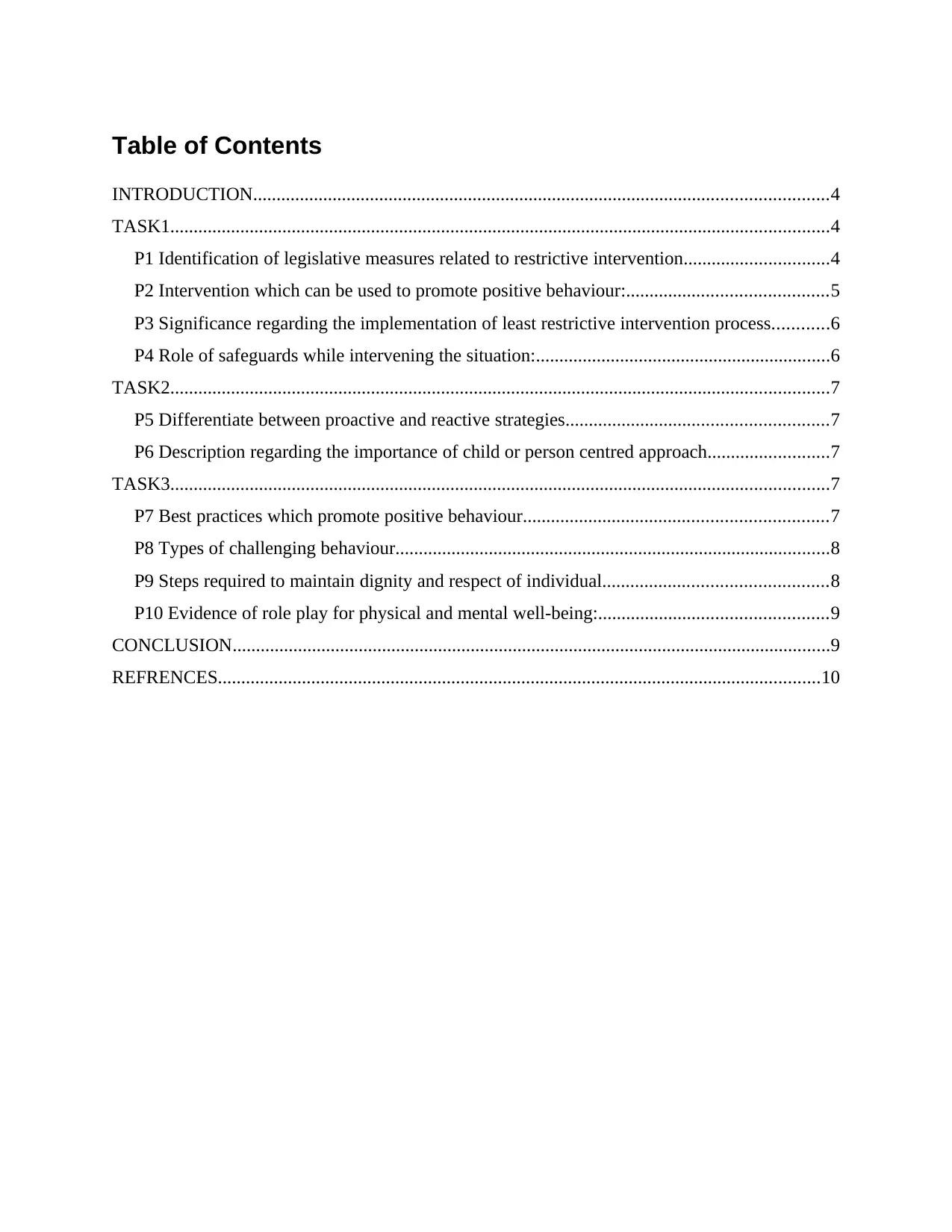
Table of Contents
INTRODUCTION...........................................................................................................................4
TASK1.............................................................................................................................................4
P1 Identification of legislative measures related to restrictive intervention...............................4
P2 Intervention which can be used to promote positive behaviour:...........................................5
P3 Significance regarding the implementation of least restrictive intervention process............6
P4 Role of safeguards while intervening the situation:...............................................................6
TASK2.............................................................................................................................................7
P5 Differentiate between proactive and reactive strategies........................................................7
P6 Description regarding the importance of child or person centred approach..........................7
TASK3.............................................................................................................................................7
P7 Best practices which promote positive behaviour.................................................................7
P8 Types of challenging behaviour.............................................................................................8
P9 Steps required to maintain dignity and respect of individual................................................8
P10 Evidence of role play for physical and mental well-being:.................................................9
CONCLUSION................................................................................................................................9
REFRENCES.................................................................................................................................10
INTRODUCTION...........................................................................................................................4
TASK1.............................................................................................................................................4
P1 Identification of legislative measures related to restrictive intervention...............................4
P2 Intervention which can be used to promote positive behaviour:...........................................5
P3 Significance regarding the implementation of least restrictive intervention process............6
P4 Role of safeguards while intervening the situation:...............................................................6
TASK2.............................................................................................................................................7
P5 Differentiate between proactive and reactive strategies........................................................7
P6 Description regarding the importance of child or person centred approach..........................7
TASK3.............................................................................................................................................7
P7 Best practices which promote positive behaviour.................................................................7
P8 Types of challenging behaviour.............................................................................................8
P9 Steps required to maintain dignity and respect of individual................................................8
P10 Evidence of role play for physical and mental well-being:.................................................9
CONCLUSION................................................................................................................................9
REFRENCES.................................................................................................................................10
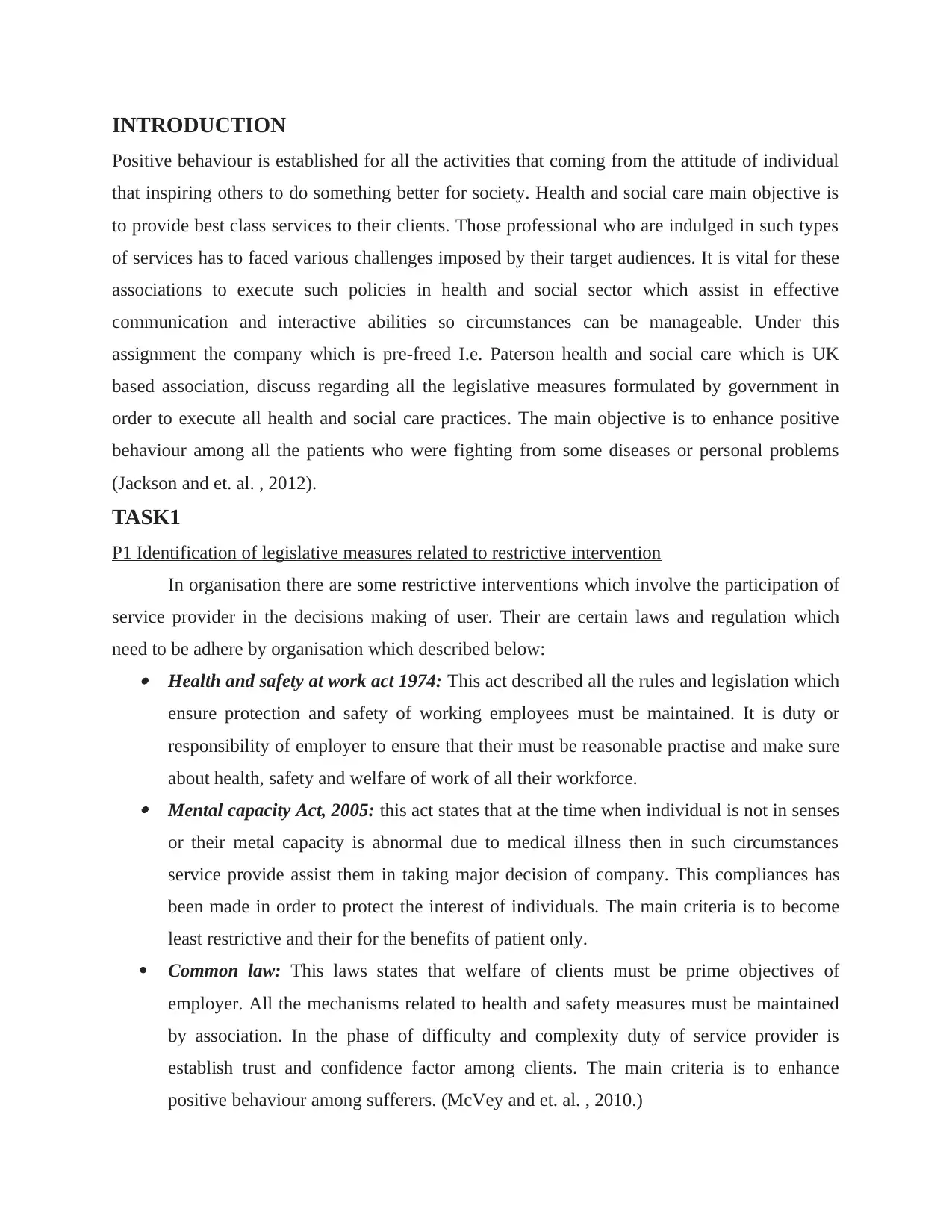
INTRODUCTION
Positive behaviour is established for all the activities that coming from the attitude of individual
that inspiring others to do something better for society. Health and social care main objective is
to provide best class services to their clients. Those professional who are indulged in such types
of services has to faced various challenges imposed by their target audiences. It is vital for these
associations to execute such policies in health and social sector which assist in effective
communication and interactive abilities so circumstances can be manageable. Under this
assignment the company which is pre-freed I.e. Paterson health and social care which is UK
based association, discuss regarding all the legislative measures formulated by government in
order to execute all health and social care practices. The main objective is to enhance positive
behaviour among all the patients who were fighting from some diseases or personal problems
(Jackson and et. al. , 2012).
TASK1
P1 Identification of legislative measures related to restrictive intervention
In organisation there are some restrictive interventions which involve the participation of
service provider in the decisions making of user. Their are certain laws and regulation which
need to be adhere by organisation which described below: Health and safety at work act 1974: This act described all the rules and legislation which
ensure protection and safety of working employees must be maintained. It is duty or
responsibility of employer to ensure that their must be reasonable practise and make sure
about health, safety and welfare of work of all their workforce. Mental capacity Act, 2005: this act states that at the time when individual is not in senses
or their metal capacity is abnormal due to medical illness then in such circumstances
service provide assist them in taking major decision of company. This compliances has
been made in order to protect the interest of individuals. The main criteria is to become
least restrictive and their for the benefits of patient only.
Common law: This laws states that welfare of clients must be prime objectives of
employer. All the mechanisms related to health and safety measures must be maintained
by association. In the phase of difficulty and complexity duty of service provider is
establish trust and confidence factor among clients. The main criteria is to enhance
positive behaviour among sufferers. (McVey and et. al. , 2010.)
Positive behaviour is established for all the activities that coming from the attitude of individual
that inspiring others to do something better for society. Health and social care main objective is
to provide best class services to their clients. Those professional who are indulged in such types
of services has to faced various challenges imposed by their target audiences. It is vital for these
associations to execute such policies in health and social sector which assist in effective
communication and interactive abilities so circumstances can be manageable. Under this
assignment the company which is pre-freed I.e. Paterson health and social care which is UK
based association, discuss regarding all the legislative measures formulated by government in
order to execute all health and social care practices. The main objective is to enhance positive
behaviour among all the patients who were fighting from some diseases or personal problems
(Jackson and et. al. , 2012).
TASK1
P1 Identification of legislative measures related to restrictive intervention
In organisation there are some restrictive interventions which involve the participation of
service provider in the decisions making of user. Their are certain laws and regulation which
need to be adhere by organisation which described below: Health and safety at work act 1974: This act described all the rules and legislation which
ensure protection and safety of working employees must be maintained. It is duty or
responsibility of employer to ensure that their must be reasonable practise and make sure
about health, safety and welfare of work of all their workforce. Mental capacity Act, 2005: this act states that at the time when individual is not in senses
or their metal capacity is abnormal due to medical illness then in such circumstances
service provide assist them in taking major decision of company. This compliances has
been made in order to protect the interest of individuals. The main criteria is to become
least restrictive and their for the benefits of patient only.
Common law: This laws states that welfare of clients must be prime objectives of
employer. All the mechanisms related to health and safety measures must be maintained
by association. In the phase of difficulty and complexity duty of service provider is
establish trust and confidence factor among clients. The main criteria is to enhance
positive behaviour among sufferers. (McVey and et. al. , 2010.)
⊘ This is a preview!⊘
Do you want full access?
Subscribe today to unlock all pages.

Trusted by 1+ million students worldwide
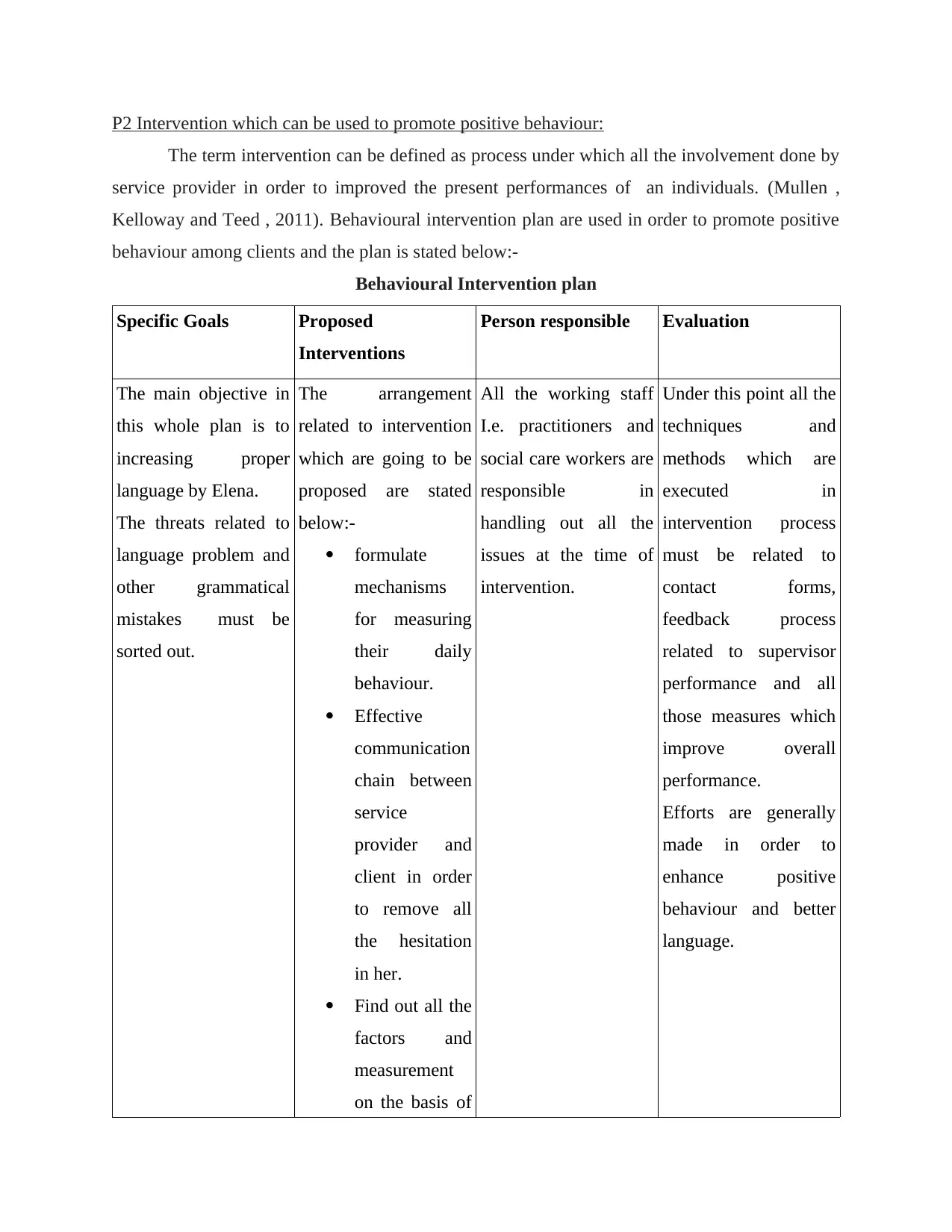
P2 Intervention which can be used to promote positive behaviour:
The term intervention can be defined as process under which all the involvement done by
service provider in order to improved the present performances of an individuals. (Mullen ,
Kelloway and Teed , 2011). Behavioural intervention plan are used in order to promote positive
behaviour among clients and the plan is stated below:-
Behavioural Intervention plan
Specific Goals Proposed
Interventions
Person responsible Evaluation
The main objective in
this whole plan is to
increasing proper
language by Elena.
The threats related to
language problem and
other grammatical
mistakes must be
sorted out.
The arrangement
related to intervention
which are going to be
proposed are stated
below:-
formulate
mechanisms
for measuring
their daily
behaviour.
Effective
communication
chain between
service
provider and
client in order
to remove all
the hesitation
in her.
Find out all the
factors and
measurement
on the basis of
All the working staff
I.e. practitioners and
social care workers are
responsible in
handling out all the
issues at the time of
intervention.
Under this point all the
techniques and
methods which are
executed in
intervention process
must be related to
contact forms,
feedback process
related to supervisor
performance and all
those measures which
improve overall
performance.
Efforts are generally
made in order to
enhance positive
behaviour and better
language.
The term intervention can be defined as process under which all the involvement done by
service provider in order to improved the present performances of an individuals. (Mullen ,
Kelloway and Teed , 2011). Behavioural intervention plan are used in order to promote positive
behaviour among clients and the plan is stated below:-
Behavioural Intervention plan
Specific Goals Proposed
Interventions
Person responsible Evaluation
The main objective in
this whole plan is to
increasing proper
language by Elena.
The threats related to
language problem and
other grammatical
mistakes must be
sorted out.
The arrangement
related to intervention
which are going to be
proposed are stated
below:-
formulate
mechanisms
for measuring
their daily
behaviour.
Effective
communication
chain between
service
provider and
client in order
to remove all
the hesitation
in her.
Find out all the
factors and
measurement
on the basis of
All the working staff
I.e. practitioners and
social care workers are
responsible in
handling out all the
issues at the time of
intervention.
Under this point all the
techniques and
methods which are
executed in
intervention process
must be related to
contact forms,
feedback process
related to supervisor
performance and all
those measures which
improve overall
performance.
Efforts are generally
made in order to
enhance positive
behaviour and better
language.
Paraphrase This Document
Need a fresh take? Get an instant paraphrase of this document with our AI Paraphraser
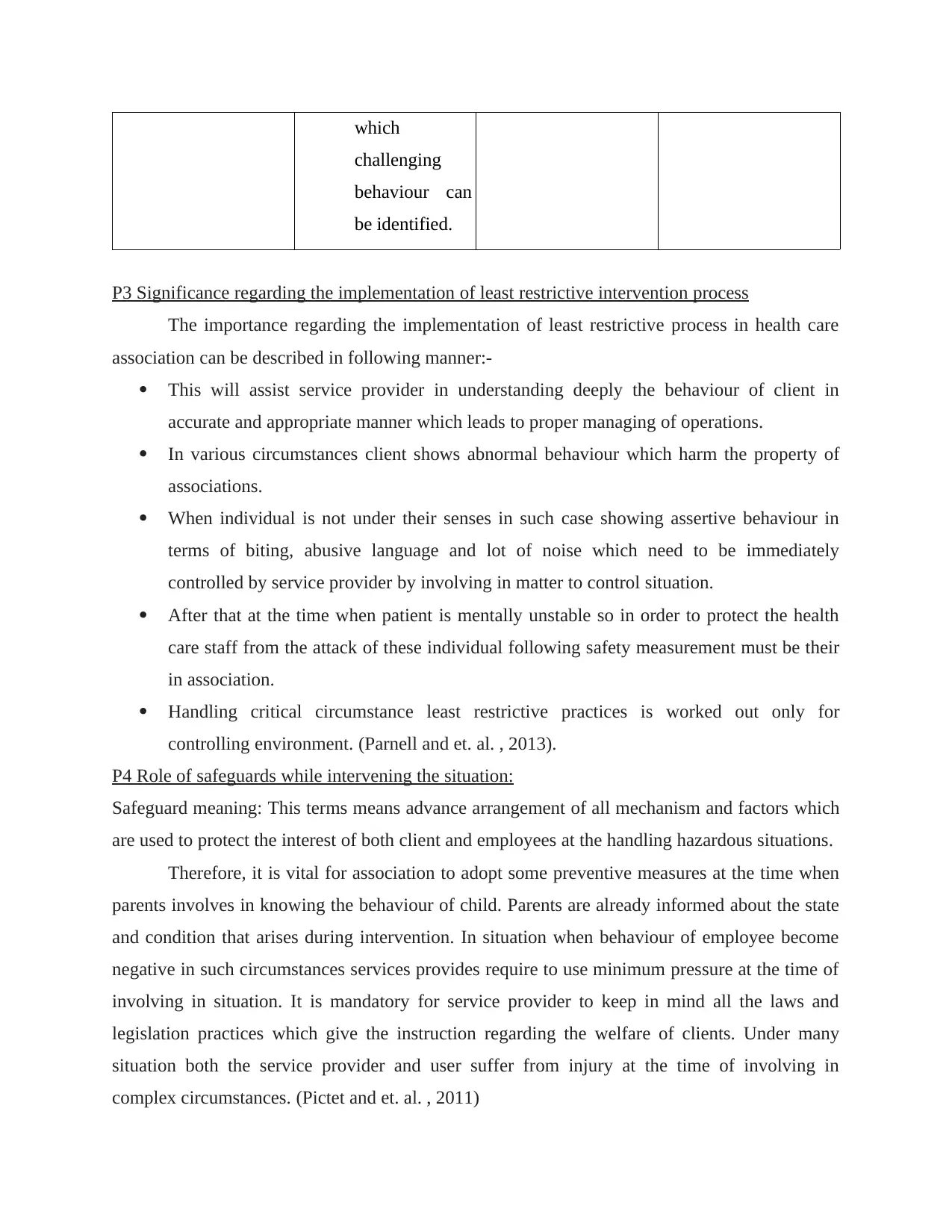
which
challenging
behaviour can
be identified.
P3 Significance regarding the implementation of least restrictive intervention process
The importance regarding the implementation of least restrictive process in health care
association can be described in following manner:-
This will assist service provider in understanding deeply the behaviour of client in
accurate and appropriate manner which leads to proper managing of operations.
In various circumstances client shows abnormal behaviour which harm the property of
associations.
When individual is not under their senses in such case showing assertive behaviour in
terms of biting, abusive language and lot of noise which need to be immediately
controlled by service provider by involving in matter to control situation.
After that at the time when patient is mentally unstable so in order to protect the health
care staff from the attack of these individual following safety measurement must be their
in association.
Handling critical circumstance least restrictive practices is worked out only for
controlling environment. (Parnell and et. al. , 2013).
P4 Role of safeguards while intervening the situation:
Safeguard meaning: This terms means advance arrangement of all mechanism and factors which
are used to protect the interest of both client and employees at the handling hazardous situations.
Therefore, it is vital for association to adopt some preventive measures at the time when
parents involves in knowing the behaviour of child. Parents are already informed about the state
and condition that arises during intervention. In situation when behaviour of employee become
negative in such circumstances services provides require to use minimum pressure at the time of
involving in situation. It is mandatory for service provider to keep in mind all the laws and
legislation practices which give the instruction regarding the welfare of clients. Under many
situation both the service provider and user suffer from injury at the time of involving in
complex circumstances. (Pictet and et. al. , 2011)
challenging
behaviour can
be identified.
P3 Significance regarding the implementation of least restrictive intervention process
The importance regarding the implementation of least restrictive process in health care
association can be described in following manner:-
This will assist service provider in understanding deeply the behaviour of client in
accurate and appropriate manner which leads to proper managing of operations.
In various circumstances client shows abnormal behaviour which harm the property of
associations.
When individual is not under their senses in such case showing assertive behaviour in
terms of biting, abusive language and lot of noise which need to be immediately
controlled by service provider by involving in matter to control situation.
After that at the time when patient is mentally unstable so in order to protect the health
care staff from the attack of these individual following safety measurement must be their
in association.
Handling critical circumstance least restrictive practices is worked out only for
controlling environment. (Parnell and et. al. , 2013).
P4 Role of safeguards while intervening the situation:
Safeguard meaning: This terms means advance arrangement of all mechanism and factors which
are used to protect the interest of both client and employees at the handling hazardous situations.
Therefore, it is vital for association to adopt some preventive measures at the time when
parents involves in knowing the behaviour of child. Parents are already informed about the state
and condition that arises during intervention. In situation when behaviour of employee become
negative in such circumstances services provides require to use minimum pressure at the time of
involving in situation. It is mandatory for service provider to keep in mind all the laws and
legislation practices which give the instruction regarding the welfare of clients. Under many
situation both the service provider and user suffer from injury at the time of involving in
complex circumstances. (Pictet and et. al. , 2011)
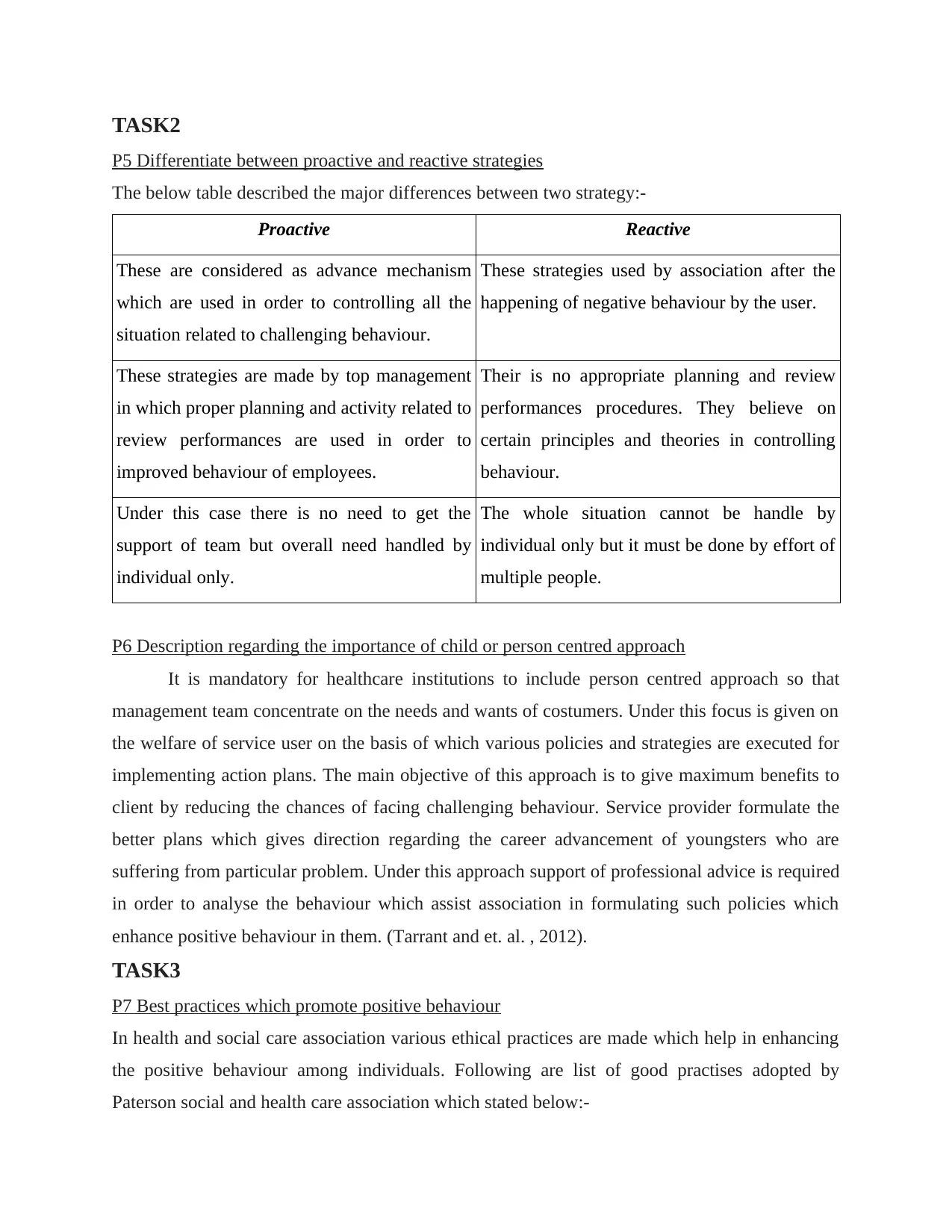
TASK2
P5 Differentiate between proactive and reactive strategies
The below table described the major differences between two strategy:-
Proactive Reactive
These are considered as advance mechanism
which are used in order to controlling all the
situation related to challenging behaviour.
These strategies used by association after the
happening of negative behaviour by the user.
These strategies are made by top management
in which proper planning and activity related to
review performances are used in order to
improved behaviour of employees.
Their is no appropriate planning and review
performances procedures. They believe on
certain principles and theories in controlling
behaviour.
Under this case there is no need to get the
support of team but overall need handled by
individual only.
The whole situation cannot be handle by
individual only but it must be done by effort of
multiple people.
P6 Description regarding the importance of child or person centred approach
It is mandatory for healthcare institutions to include person centred approach so that
management team concentrate on the needs and wants of costumers. Under this focus is given on
the welfare of service user on the basis of which various policies and strategies are executed for
implementing action plans. The main objective of this approach is to give maximum benefits to
client by reducing the chances of facing challenging behaviour. Service provider formulate the
better plans which gives direction regarding the career advancement of youngsters who are
suffering from particular problem. Under this approach support of professional advice is required
in order to analyse the behaviour which assist association in formulating such policies which
enhance positive behaviour in them. (Tarrant and et. al. , 2012).
TASK3
P7 Best practices which promote positive behaviour
In health and social care association various ethical practices are made which help in enhancing
the positive behaviour among individuals. Following are list of good practises adopted by
Paterson social and health care association which stated below:-
P5 Differentiate between proactive and reactive strategies
The below table described the major differences between two strategy:-
Proactive Reactive
These are considered as advance mechanism
which are used in order to controlling all the
situation related to challenging behaviour.
These strategies used by association after the
happening of negative behaviour by the user.
These strategies are made by top management
in which proper planning and activity related to
review performances are used in order to
improved behaviour of employees.
Their is no appropriate planning and review
performances procedures. They believe on
certain principles and theories in controlling
behaviour.
Under this case there is no need to get the
support of team but overall need handled by
individual only.
The whole situation cannot be handle by
individual only but it must be done by effort of
multiple people.
P6 Description regarding the importance of child or person centred approach
It is mandatory for healthcare institutions to include person centred approach so that
management team concentrate on the needs and wants of costumers. Under this focus is given on
the welfare of service user on the basis of which various policies and strategies are executed for
implementing action plans. The main objective of this approach is to give maximum benefits to
client by reducing the chances of facing challenging behaviour. Service provider formulate the
better plans which gives direction regarding the career advancement of youngsters who are
suffering from particular problem. Under this approach support of professional advice is required
in order to analyse the behaviour which assist association in formulating such policies which
enhance positive behaviour in them. (Tarrant and et. al. , 2012).
TASK3
P7 Best practices which promote positive behaviour
In health and social care association various ethical practices are made which help in enhancing
the positive behaviour among individuals. Following are list of good practises adopted by
Paterson social and health care association which stated below:-
⊘ This is a preview!⊘
Do you want full access?
Subscribe today to unlock all pages.

Trusted by 1+ million students worldwide
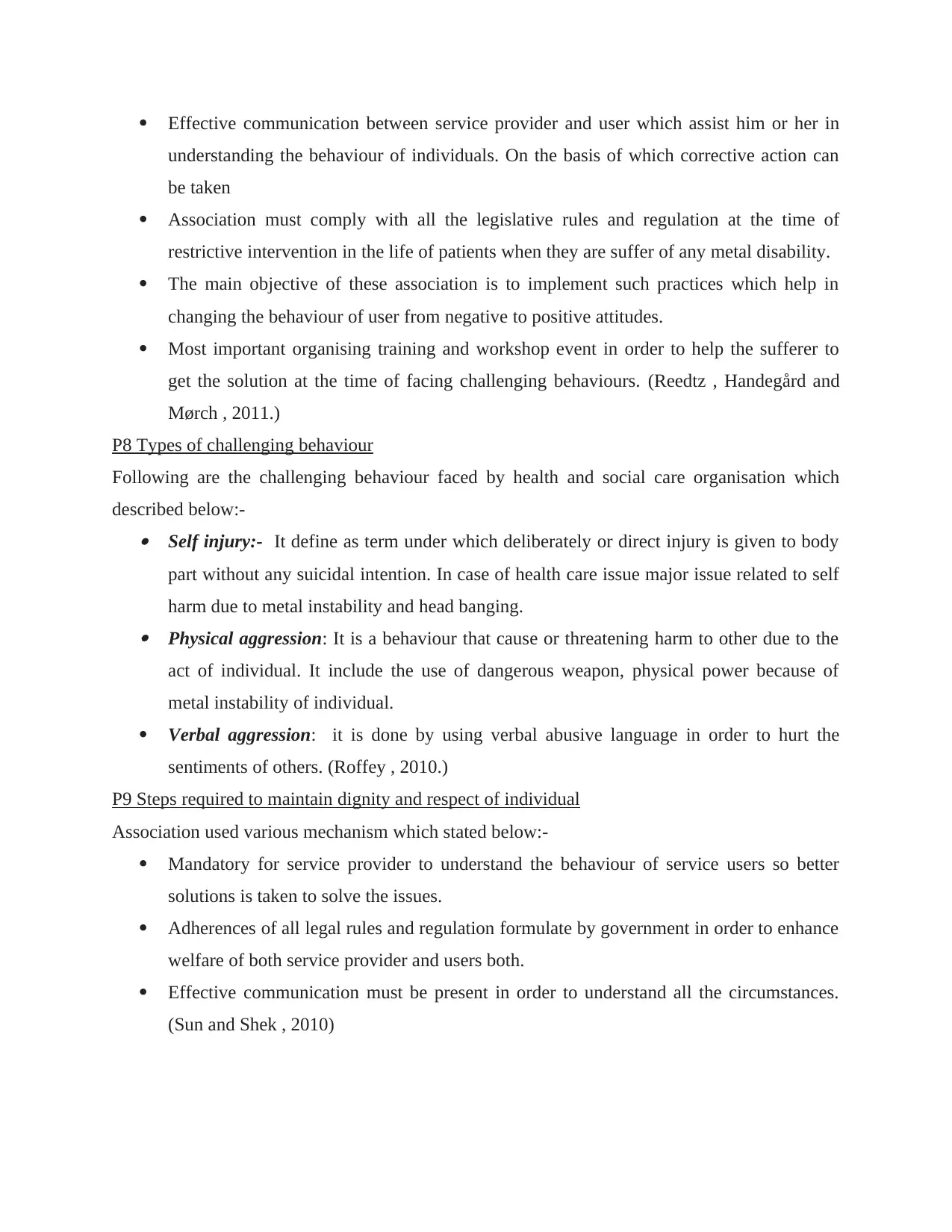
Effective communication between service provider and user which assist him or her in
understanding the behaviour of individuals. On the basis of which corrective action can
be taken
Association must comply with all the legislative rules and regulation at the time of
restrictive intervention in the life of patients when they are suffer of any metal disability.
The main objective of these association is to implement such practices which help in
changing the behaviour of user from negative to positive attitudes.
Most important organising training and workshop event in order to help the sufferer to
get the solution at the time of facing challenging behaviours. (Reedtz , Handegård and
Mørch , 2011.)
P8 Types of challenging behaviour
Following are the challenging behaviour faced by health and social care organisation which
described below:- Self injury:- It define as term under which deliberately or direct injury is given to body
part without any suicidal intention. In case of health care issue major issue related to self
harm due to metal instability and head banging. Physical aggression: It is a behaviour that cause or threatening harm to other due to the
act of individual. It include the use of dangerous weapon, physical power because of
metal instability of individual.
Verbal aggression: it is done by using verbal abusive language in order to hurt the
sentiments of others. (Roffey , 2010.)
P9 Steps required to maintain dignity and respect of individual
Association used various mechanism which stated below:-
Mandatory for service provider to understand the behaviour of service users so better
solutions is taken to solve the issues.
Adherences of all legal rules and regulation formulate by government in order to enhance
welfare of both service provider and users both.
Effective communication must be present in order to understand all the circumstances.
(Sun and Shek , 2010)
understanding the behaviour of individuals. On the basis of which corrective action can
be taken
Association must comply with all the legislative rules and regulation at the time of
restrictive intervention in the life of patients when they are suffer of any metal disability.
The main objective of these association is to implement such practices which help in
changing the behaviour of user from negative to positive attitudes.
Most important organising training and workshop event in order to help the sufferer to
get the solution at the time of facing challenging behaviours. (Reedtz , Handegård and
Mørch , 2011.)
P8 Types of challenging behaviour
Following are the challenging behaviour faced by health and social care organisation which
described below:- Self injury:- It define as term under which deliberately or direct injury is given to body
part without any suicidal intention. In case of health care issue major issue related to self
harm due to metal instability and head banging. Physical aggression: It is a behaviour that cause or threatening harm to other due to the
act of individual. It include the use of dangerous weapon, physical power because of
metal instability of individual.
Verbal aggression: it is done by using verbal abusive language in order to hurt the
sentiments of others. (Roffey , 2010.)
P9 Steps required to maintain dignity and respect of individual
Association used various mechanism which stated below:-
Mandatory for service provider to understand the behaviour of service users so better
solutions is taken to solve the issues.
Adherences of all legal rules and regulation formulate by government in order to enhance
welfare of both service provider and users both.
Effective communication must be present in order to understand all the circumstances.
(Sun and Shek , 2010)
Paraphrase This Document
Need a fresh take? Get an instant paraphrase of this document with our AI Paraphraser
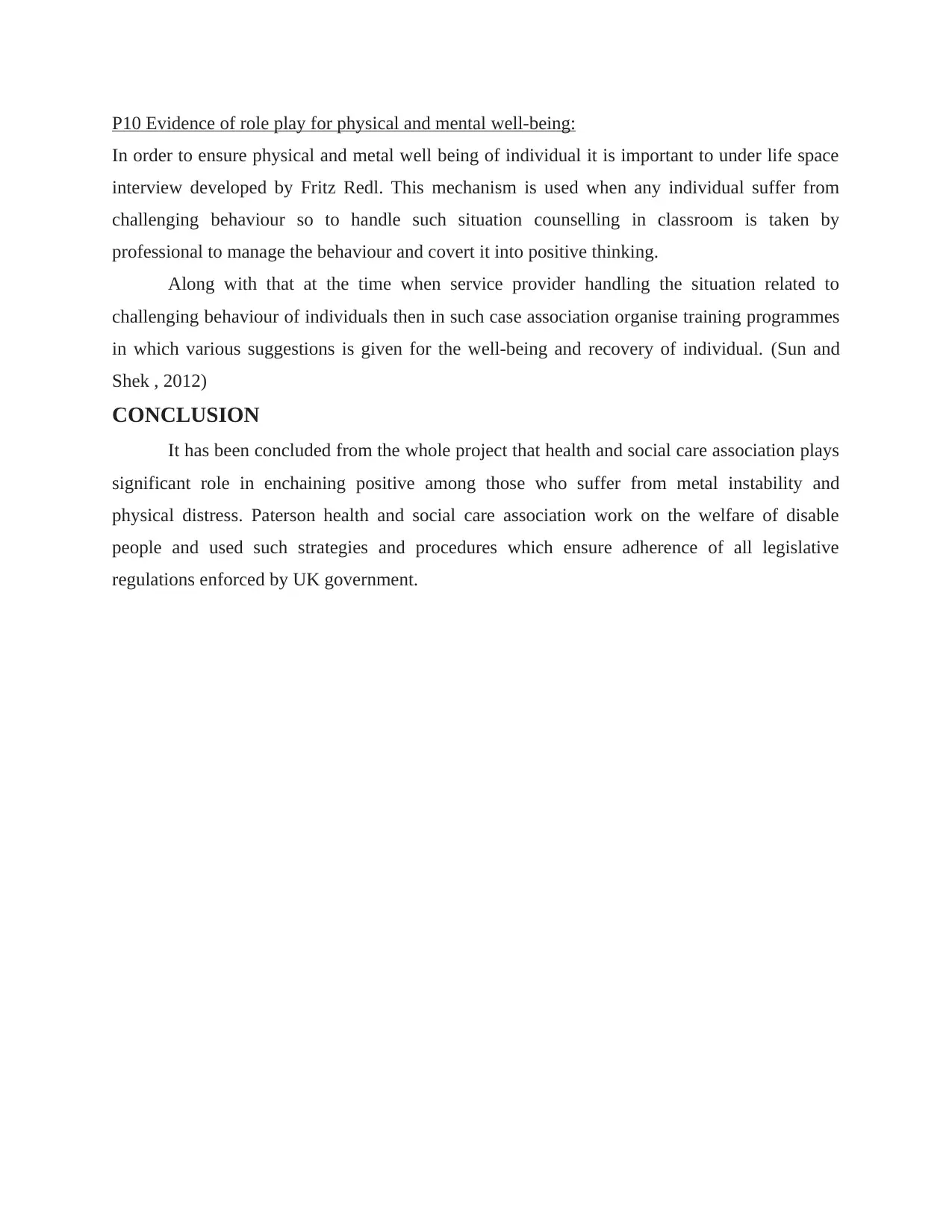
P10 Evidence of role play for physical and mental well-being:
In order to ensure physical and metal well being of individual it is important to under life space
interview developed by Fritz Redl. This mechanism is used when any individual suffer from
challenging behaviour so to handle such situation counselling in classroom is taken by
professional to manage the behaviour and covert it into positive thinking.
Along with that at the time when service provider handling the situation related to
challenging behaviour of individuals then in such case association organise training programmes
in which various suggestions is given for the well-being and recovery of individual. (Sun and
Shek , 2012)
CONCLUSION
It has been concluded from the whole project that health and social care association plays
significant role in enchaining positive among those who suffer from metal instability and
physical distress. Paterson health and social care association work on the welfare of disable
people and used such strategies and procedures which ensure adherence of all legislative
regulations enforced by UK government.
In order to ensure physical and metal well being of individual it is important to under life space
interview developed by Fritz Redl. This mechanism is used when any individual suffer from
challenging behaviour so to handle such situation counselling in classroom is taken by
professional to manage the behaviour and covert it into positive thinking.
Along with that at the time when service provider handling the situation related to
challenging behaviour of individuals then in such case association organise training programmes
in which various suggestions is given for the well-being and recovery of individual. (Sun and
Shek , 2012)
CONCLUSION
It has been concluded from the whole project that health and social care association plays
significant role in enchaining positive among those who suffer from metal instability and
physical distress. Paterson health and social care association work on the welfare of disable
people and used such strategies and procedures which ensure adherence of all legislative
regulations enforced by UK government.
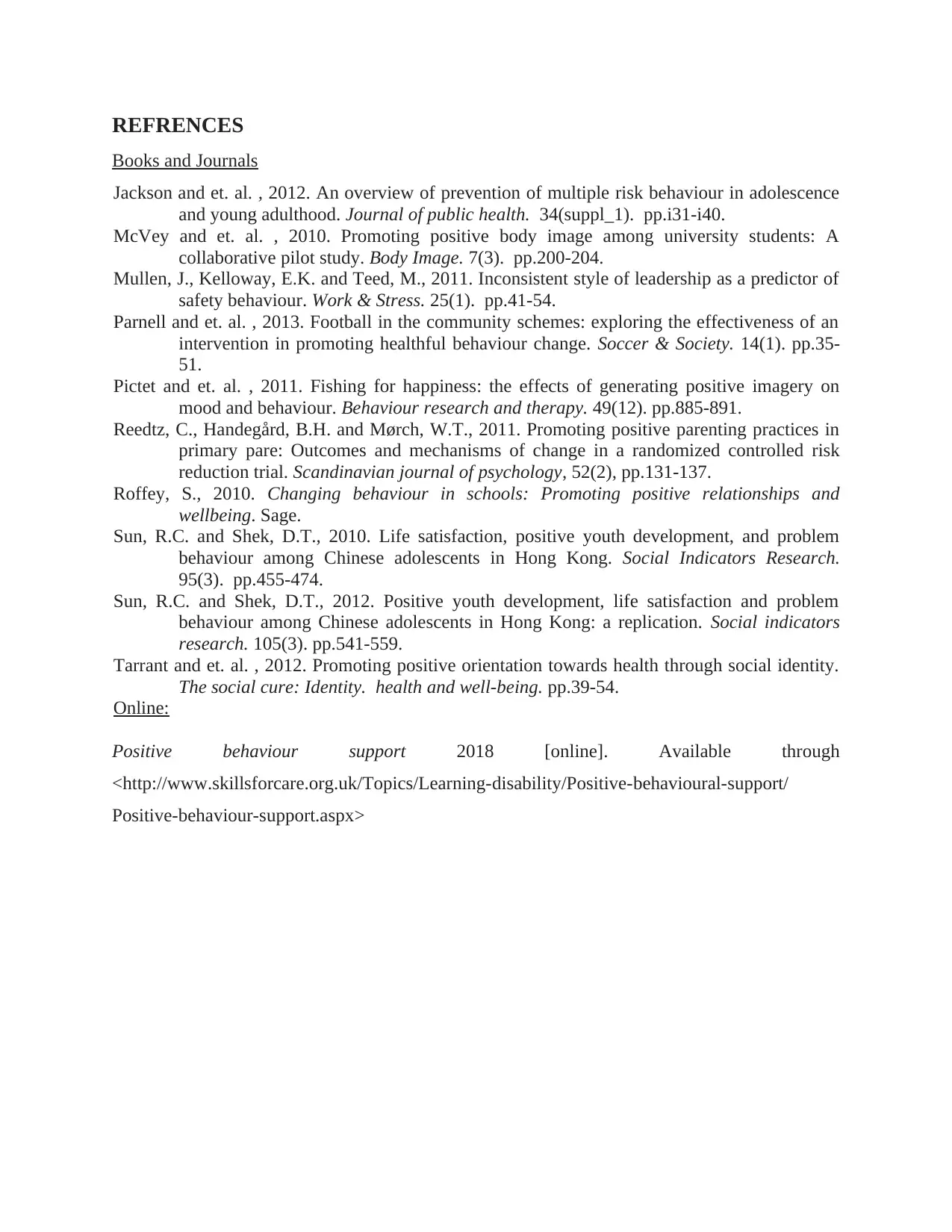
REFRENCES
Books and Journals
Jackson and et. al. , 2012. An overview of prevention of multiple risk behaviour in adolescence
and young adulthood. Journal of public health. 34(suppl_1). pp.i31-i40.
McVey and et. al. , 2010. Promoting positive body image among university students: A
collaborative pilot study. Body Image. 7(3). pp.200-204.
Mullen, J., Kelloway, E.K. and Teed, M., 2011. Inconsistent style of leadership as a predictor of
safety behaviour. Work & Stress. 25(1). pp.41-54.
Parnell and et. al. , 2013. Football in the community schemes: exploring the effectiveness of an
intervention in promoting healthful behaviour change. Soccer & Society. 14(1). pp.35-
51.
Pictet and et. al. , 2011. Fishing for happiness: the effects of generating positive imagery on
mood and behaviour. Behaviour research and therapy. 49(12). pp.885-891.
Reedtz, C., Handegård, B.H. and Mørch, W.T., 2011. Promoting positive parenting practices in
primary pare: Outcomes and mechanisms of change in a randomized controlled risk
reduction trial. Scandinavian journal of psychology, 52(2), pp.131-137.
Roffey, S., 2010. Changing behaviour in schools: Promoting positive relationships and
wellbeing. Sage.
Sun, R.C. and Shek, D.T., 2010. Life satisfaction, positive youth development, and problem
behaviour among Chinese adolescents in Hong Kong. Social Indicators Research.
95(3). pp.455-474.
Sun, R.C. and Shek, D.T., 2012. Positive youth development, life satisfaction and problem
behaviour among Chinese adolescents in Hong Kong: a replication. Social indicators
research. 105(3). pp.541-559.
Tarrant and et. al. , 2012. Promoting positive orientation towards health through social identity.
The social cure: Identity. health and well-being. pp.39-54.
Online:
Positive behaviour support 2018 [online]. Available through
<http://www.skillsforcare.org.uk/Topics/Learning-disability/Positive-behavioural-support/
Positive-behaviour-support.aspx>
Books and Journals
Jackson and et. al. , 2012. An overview of prevention of multiple risk behaviour in adolescence
and young adulthood. Journal of public health. 34(suppl_1). pp.i31-i40.
McVey and et. al. , 2010. Promoting positive body image among university students: A
collaborative pilot study. Body Image. 7(3). pp.200-204.
Mullen, J., Kelloway, E.K. and Teed, M., 2011. Inconsistent style of leadership as a predictor of
safety behaviour. Work & Stress. 25(1). pp.41-54.
Parnell and et. al. , 2013. Football in the community schemes: exploring the effectiveness of an
intervention in promoting healthful behaviour change. Soccer & Society. 14(1). pp.35-
51.
Pictet and et. al. , 2011. Fishing for happiness: the effects of generating positive imagery on
mood and behaviour. Behaviour research and therapy. 49(12). pp.885-891.
Reedtz, C., Handegård, B.H. and Mørch, W.T., 2011. Promoting positive parenting practices in
primary pare: Outcomes and mechanisms of change in a randomized controlled risk
reduction trial. Scandinavian journal of psychology, 52(2), pp.131-137.
Roffey, S., 2010. Changing behaviour in schools: Promoting positive relationships and
wellbeing. Sage.
Sun, R.C. and Shek, D.T., 2010. Life satisfaction, positive youth development, and problem
behaviour among Chinese adolescents in Hong Kong. Social Indicators Research.
95(3). pp.455-474.
Sun, R.C. and Shek, D.T., 2012. Positive youth development, life satisfaction and problem
behaviour among Chinese adolescents in Hong Kong: a replication. Social indicators
research. 105(3). pp.541-559.
Tarrant and et. al. , 2012. Promoting positive orientation towards health through social identity.
The social cure: Identity. health and well-being. pp.39-54.
Online:
Positive behaviour support 2018 [online]. Available through
<http://www.skillsforcare.org.uk/Topics/Learning-disability/Positive-behavioural-support/
Positive-behaviour-support.aspx>
⊘ This is a preview!⊘
Do you want full access?
Subscribe today to unlock all pages.

Trusted by 1+ million students worldwide
1 out of 9
Related Documents
Your All-in-One AI-Powered Toolkit for Academic Success.
+13062052269
info@desklib.com
Available 24*7 on WhatsApp / Email
![[object Object]](/_next/static/media/star-bottom.7253800d.svg)
Unlock your academic potential
Copyright © 2020–2025 A2Z Services. All Rights Reserved. Developed and managed by ZUCOL.





